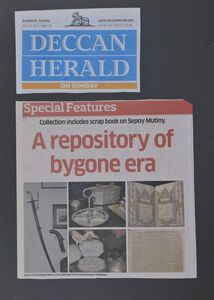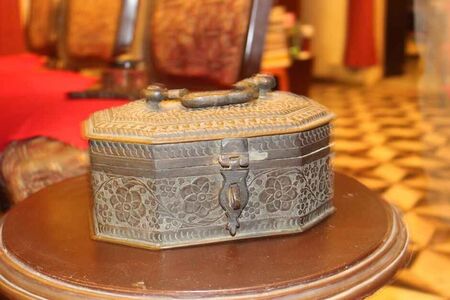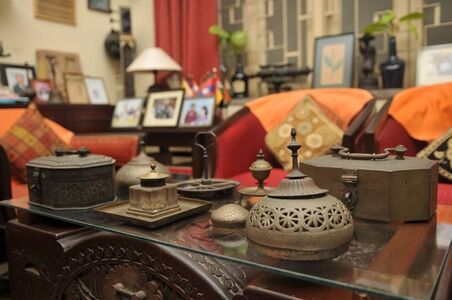The splendour that reflected in the court of Nawab Wajid Ali Shah, the last independent ruler of the kingdom of Awadh--present-day Lucknow in Uttar Pradesh--is a tale of myth and legends. While some of this glory can still be witnessed in what the Nawabs of Awadh left behind, a brilliant audio-visual depiction of the grandeur can be felt watching “Shatranj ke Khilari”, the multilingual feature film auteur Satyajit Ray made.
Before the British government annexed the small kingdom in northern India in a precursor to the Sepoy Mutiny of 1857, often called the “first war of Indian independence”, Awadh or Oudh was a flourishing principality, ruled by the benevolent Wajid Ali Shah, a man of art, letters and Urdu culture.
Bits and pieces of the glorious time can also be seen in the living room of Professor Aloke Kumar, an academic living in Kolkata. Walking into Prof Kumar’s house is like walking through the annals of 19th century India, where a cornucopia of history comes alive in knick-knacks, furniture, wall-hangings, weapons and items used by the Nawabs and British officials. From ceremonial swords to newspapers of the time, from antique engravings depicting moments in the Sepoy Mutiny to old maps, Prof Kumar’s living room provides a glimpse into a bygone era.

All this, however, started with a request from the master filmmaker, who knew Prof Kumar’s father, Nirmal Chandra Kumar, an antiquarian and a collector of old book. Ray was a regular visitor to Kumar, which was a destination for anybody looking for rare tomes. While the interaction turned into a lifelong friendship between Ray and Nirmal Chandra Kumar, the antiquarian, the filmmaker requested him to help him out when he embarked on the journey to make the period film.
The first item acquired by Kumar for Ray was a 'paandaan' or a box where betel leaves, assorted condiments and spices were kept to make paan for Nawab Wajid Ali Shah. A silver octagonal box with separate compartments for each of the stuff, needed to make a paan. Along with the paan-daan, the Kumar also bought a paan server, a small silver utensil with a handle on top to which paan were hung with strings for the Nawab and other royalty to have at will.
Over time, collecting antiques for Ray's proposed film, became an obsession with Kumar, who would get in touch with collectors and owners of objects that may be required for the film and buy them. The centre-piece of the precious collection is a hand-written Holy Quran.
“In the beginning I was quite embarrassed by what my father did. Imagine a middle-aged gentleman with a family, browsing through books all day long. Well, that didn’t make a very impressive father to me,” recalled Prof Kumar. He said that his father had a collection of more than a lakh books at his central Kolkata house, relating to every subject.
As the establishment was a repository of rare books, maps, prints and manuscripts, Ray turned to Kumar to get a vivid perspective of Lucknow from the Nawab’s era. Kumar provided Bansi Chandragupta, prominent art director and a part of Ray’s team with swords, pistols, Jamewar shawls, the paan-daan and a variety of other objects to lend an authentic flavour to the film. Prof Kumar has found a place for rare objects at his south Kolkata residence.
The first thing that catches one’s eye at Prof Kumar’s living room is a black, hard-bound scrapbook, that Kumar bought from leading auction house, Sotheby’s of London. The pages are filled with newspaper cuttings from Austrian and German newspapers dating back to the Sepoy Mutiny. The cuttings were personally collected and preserved by GC Urmstrong, a British Army official.
“The scrapbook was very helpful for Ray as it provided significant perspective of the time. He wanted to have a deep insight into the real happenings of the time,” said Prof Kumar. Along with engravings dating back to the Mutiny and newspaper cuttings, there are a number of rare books, including seven volumes of The History of Indian Mutiny by Charles Ball, published in 1875, A History of Indian Mutiny by G W Forrest, published in 1904 and Kaye and Malleson’s History of Indian Mutiny from 1896. Other rare items jostling for space in Prof Kumar’s living room are maps and colourful and detailed engravings from the Mutiny era, showing troop positions as on May 1857, Lieutenant De Kantzow holding the 9th Sepoy Regiment at Mynpooree, mutineers’ cavalry attacking an infantry square at the Battle of Cawnpore and Sir William Peel moving up canons at Dilkhoosha among many others.
One wall in the room, which is decorated with number of these framed engravings and a variety of other antiques, also holds a ceremonial sword and a flintlock pistol, introduced in the 17th Century, where gunpowder was loaded through the barrel with a rod. “The sword was manufactured by WHartman & Company of the UK. It was gifted to my father by his friend Colonel OLJ Milligan. The Duke of Wellington famously carried a non-regulation Mameluke-hilted sword based on the patterns he had encountered during his years in India. When a new sword was prescribed for British Army Generals in 1831, its design was closely based on the Duke’s favourite style,” he said.
While the paan-daan holds a place of pride, other items that draw attention are an attar-daan or a perfume container and an incense-holder. Prof Kumar pointed out that in those days, it was customary to keep paan boxes fully stored when offering to visiting guests, often a sign of a family’s stature and wealth. The one that Prof Kumar possesses is from the Mughal era with beautiful pure silver inlay in a traditional Muslim “Okir” scroll pattern, an item that has been shown in Shatranj ke Khiladi a number of times.
Talking about adding on to his father’s collection, Prof Kumar said, “Being an antiquarian is a tough job but I wish to preserve what my father had collected.” When asked whether he is approached by collectors or auction houses, the professor with the University of Calcutta and IIM-Calcutta, said:“Actually we have not talked about these things."




